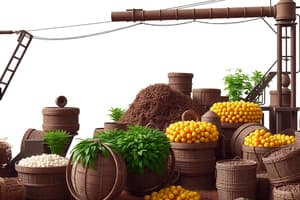Podcast
Questions and Answers
Which factor does NOT directly contribute to increasing the added value of a product?
Which factor does NOT directly contribute to increasing the added value of a product?
- Established brand reputation
- Comprehensive after-sales service
- Strategic location of the business
- The cost of raw materials (correct)
Gelato Cangan emphasizes several factors to enhance its added value. Which of the following is most likely to be considered LEAST impactful to their added value strategy?
Gelato Cangan emphasizes several factors to enhance its added value. Which of the following is most likely to be considered LEAST impactful to their added value strategy?
- Strategic location near tourist attractions
- Minimizing packaging costs (correct)
- Focus on high-quality ingredients
- Highlighting health benefits
A country heavily reliant on exporting raw materials like minerals and agricultural products is primarily operating within which economic sector?
A country heavily reliant on exporting raw materials like minerals and agricultural products is primarily operating within which economic sector?
- Secondary Sector
- Primary Sector (correct)
- Tertiary Sector
- Quaternary Sector
Why are natural resources considered particularly important within the context of the South African economy?
Why are natural resources considered particularly important within the context of the South African economy?
Which activity represents a direct effort to preserve natural resources, particularly in the context of a business operating in the primary sector?
Which activity represents a direct effort to preserve natural resources, particularly in the context of a business operating in the primary sector?
What is a key environmental impact typically associated with the secondary sector?
What is a key environmental impact typically associated with the secondary sector?
A company focusing on developing sustainable resource management strategies and promoting renewable energy sources is contributing to the preservation of natural resources primarily within which sector?
A company focusing on developing sustainable resource management strategies and promoting renewable energy sources is contributing to the preservation of natural resources primarily within which sector?
What skill is MOST crucial for success in the tertiary sector compared to the primary and secondary sectors?
What skill is MOST crucial for success in the tertiary sector compared to the primary and secondary sectors?
Which of the following best illustrates the relationship between scarcity, choice, and opportunity cost?
Which of the following best illustrates the relationship between scarcity, choice, and opportunity cost?
In a car manufacturing plant, some workers design the cars, some test them, and some market them. Which concept does this demonstrate?
In a car manufacturing plant, some workers design the cars, some test them, and some market them. Which concept does this demonstrate?
A local bakery decides to focus solely on producing sourdough bread due to high demand and specialized equipment. What economic concept does this best represent?
A local bakery decides to focus solely on producing sourdough bread due to high demand and specialized equipment. What economic concept does this best represent?
A furniture company purchases wood for $50, hardware for $30, and fabric for $20 to produce a chair. If the chair sells for $150, what is the added value?
A furniture company purchases wood for $50, hardware for $30, and fabric for $20 to produce a chair. If the chair sells for $150, what is the added value?
Which of the following is NOT considered a factor of production?
Which of the following is NOT considered a factor of production?
A country has a limited supply of oil, but the population's desire for gasoline and heating oil is virtually unlimited. What economic problem does this best represent?
A country has a limited supply of oil, but the population's desire for gasoline and heating oil is virtually unlimited. What economic problem does this best represent?
What is a potential disadvantage of division of labour in a manufacturing company?
What is a potential disadvantage of division of labour in a manufacturing company?
Which scenario best illustrates the role of an entrepreneur in the factors of production?
Which scenario best illustrates the role of an entrepreneur in the factors of production?
Flashcards
Scarcity
Scarcity
Unlimited wants exceed limited resources, creating a shortage.
Need
Need
Goods/services essential for survival.
Want
Want
Goods/services desired but not essential.
Factors of Production (FOP)
Factors of Production (FOP)
Signup and view all the flashcards
Land (FOP)
Land (FOP)
Signup and view all the flashcards
Labour (FOP)
Labour (FOP)
Signup and view all the flashcards
Capital (FOP)
Capital (FOP)
Signup and view all the flashcards
Entrepreneurship (FOP)
Entrepreneurship (FOP)
Signup and view all the flashcards
Selling Price (SP)
Selling Price (SP)
Signup and view all the flashcards
Added Value Factors
Added Value Factors
Signup and view all the flashcards
Primary Sector
Primary Sector
Signup and view all the flashcards
Secondary Sector
Secondary Sector
Signup and view all the flashcards
Tertiary Sector
Tertiary Sector
Signup and view all the flashcards
Extraction
Extraction
Signup and view all the flashcards
Preservation
Preservation
Signup and view all the flashcards
Unskilled labor
Unskilled labor
Signup and view all the flashcards
Study Notes
- Business activity addresses the economic problem of unlimited wants and limited resources, creating scarcity.
- Scarcity arises from a lack of sufficient products to satisfy the population's total wants.
- It is the want for a good or service beyond what is essential for living.
- The shortage of resources to produce these wants and needs leads to an economic problem.
- Factors of production are limited in supply.
Four Factors of Production (FOP)
- Capital includes the finance, machinery, and equipment required to make a product or service (e.g., a stand mixer for a baker).
- Labour refers to the people who combine factors to produce goods or services (e.g., an owner of a restaurant).
- Land encompasses all natural resources used in production (e.g., office space, fields).
- Entrepreneurship involves combining the other three factors (capital, labour, land).
Limited Resources and Economic Problem
- Limited resources lead to scarcity, causing choices and opportunity costs, impacting the value of what didn't get chosen.
- Specialization involves people or businesses concentrating on what they are best at.
- Division of labour splits production processes into different tasks, performed individually, forming a type of specialization.
- One result of division of labour results in increased worker efficiencies
Advantages of Division of Labour
- Workers become trained and specialize in tasks, increasing efficiency and output.
- Less time is wasted moving from one workspace to another.
Disadvantages of Division of Labour
- Workers can become bored doing one job, reducing efficiency.
- If one worker is absent, production may stop if nobody else can do their job.
- Production is less without that worker
Purpose of Business Activity
- People have unlimited wants.
- The factors of production supply are in limited demand, creating a shortage and economic problems.
- Choosing a route of best alternative, leads to opportunity cost.
- Specialization improves the efficient use of resources.
Added Value
- Added value is the difference between the selling price of a product and the cost of bought materials and components.
- Factors to increase added value include location, after-sales service, brand recognition and/ or marketing
Factors that can increase Added Value
- Increased general qualities
- An ideal location
- Health benefits
- Appealing Packaging
Classification of Business: Economic Sectors
- The three economic sectors are primary, secondary, and tertiary.
- The primary sector involves the extraction of raw materials(e.g., farming).
- The secondary sector focuses on the manufacturing process (e.g., baking bread).
- The tertiary sector involves retail products or services (e.g., retailer, real estate agent).
- The CSA (Community Supported Agriculture) sector includes minerals, fresh water, sugar, oranges, and is an increasingly exported value
Importance of Natural Resources in South Africa
- South Africa's natural resources support mining, tourism, and agriculture such as Table mountain sight seeing.
- Supports employment especially for people with informal education.
- Offers opportunity to increase exportation leading to increased GDP in foreign currency terms
Preservation of Natural Resources
- Some natural resources are renewable, while minerals are not.
- Conserving resources is a responsiblity.
Protecting the Environment
- Actions to protect the enviroment
- Plant more trees
- Do not waste water
- Use renewable energy
Primary Sector Labour
- A primary skilled labourer: does not require formal education.
- Types of skills in the primary sector require manual labour such as construction furniture makers.
Secondary Sector
- Preservation resources in the secondary level have an increased degree on availibility.
- The water, air , noise pollution have an impact on society.
- Types of shills secondary secor requires an important source of job cruation.
- Includes specific training , but formal based ducation.
Tertiary Sector
- Contributes heavily to South Africa's economy.
- The preservation of natural resources in this sector has a more indirect impact.
- Knowledge of sustainable resources is extremely important.
- Skills typically required in the tertiary sector include formal base skills, creative thinking, problem-solving skills and competence with technological tools.
Studying That Suits You
Use AI to generate personalized quizzes and flashcards to suit your learning preferences.
Related Documents
Description
Business activity tackles scarcity, the core economic problem arising from unlimited wants and limited resources. Scarcity forces choices due to insufficient resources for production. Factors of production—capital, labour, land, and entrepreneurship—are limited, leading to opportunity costs.




